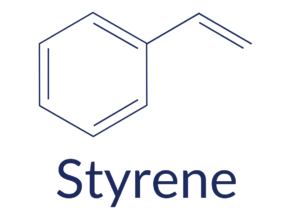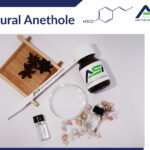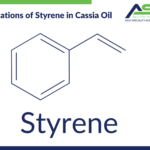Table of Content
ToggleGeneral information of Styrene
Identity
CAS no: 100-42-5
Molecular formula: C8H8
Chemical formation: C6H5CH=CH2
The IUPAC name for styrene is phenylethene. It is also known as vinylbenzene, ethenylbenzene, and styrol.

Physicochemical properties
Property Value
Physical state Colourless, viscous liquid
Melting point -30.6 °C
Boiling point 145 °C
Vapour pressure 0.6 kPa at 20 °C
Density 0.91 g/cm3 at 20 °C
Water solubility 300 mg/litre at 20 °C
Organoleptic properties
The average taste threshold reported for styrene in water at 40 °C is 0.12 mg/litre. Styrene has a sweet odour, and odour thresholds for solutions in water range from 0.02 to 2.6 mg/litre. An odour threshold for solutions in water at 60 °C of 0.0036 mg/litre has also been reported. The estimated odour threshold for styrene in air is 0.1 mg/m3.
Major uses
Styrene is used predominately in the production of polystyrene plastics and resins. Styrene is also used as an intermediate in the synthesis of materials used for ion exchange resins and to produce copolymers.
Environmental fate.
Indoor air is the principal route of styrene exposure for the general population. Average indoor air levels of styrene are in the range of 1 to 9 µg/m3, attributable to emissions from building materials, consumer products, and tobacco smoke. Ambient air in urban locations contains styrene at average concentrations of 0.29 to 3.8 µg/m3, while styrene in rural and suburban air has been measured at 0.28 to 0.34 µg/m3, according to U.S. Department of Health and Human Services report.
Styrene in air is very reactive in the presence of hydroxyl radicals and ozone, having a halflife of about 2 h. In air, it is oxidized to aldehydes, ketones, and benzoic acid. High relative molecular mass peroxides can also be formed.
Hazard summary
Acute (short-term) exposure to styrene in humans results in mucous membrane and eye irritation, and gastrointestinal effects. Chronic (long-term) exposure to styrene in humans results in effects on the central nervous system (CNS), such as headache, fatigue, weakness, and depression, CSN dysfunction, hearing loss, and peripheral neuropathy.
Human studies are inconclusive on the reproductive and developmental effects of styrene; several studies did not report an increase in developmental effects in women who worked in the plastics industry, while an increased frequency of spontaneous abortions and decreased frequency of births were reported in another study. Several epidemiologic studies suggest there may be an association between styrene exposure and an increased risk of leukemia and lymphoma. However, the evidence is inconclusive due to confounding factors.
Styrene in Cassia Oil
Styrene in food
Styrene is the starting material used in the production of styrene-based polymers which are used in many food packaging applications, and it can be detected in a variety of food products. This incidence can partly be explained by the migration into food from the packaging, especially for dairy products for which polystyrene packaging is frequently used. An indirect contamination through air during food storage has been also demonstrated.
Any incidence of styrene in food is not related to an exogenous contamination since styrene is also a compound which occurs naturally in foods. It has been identified in many different raw agricultural commodities such as fruits, cereals, coffee beans and beef meat as well as in processed foods such as olive oil or beer. The formation of styrene in food can be explained by different mechanisms: It can be a by-product of yeasts or molds naturally present on food or it can be an intermediate metabolite of foodstuffs.
Styrene in Cassia Oil
Among vegetal foods, cinnamon represents a special case. The level of styrene in fruits is generally very low (<3μg/kg). In cinnamon, concentrations as high as 40 mg/kg have been reported. The structure of styrene is contained in the cinnamaldehyde that is the major flavouring compound of cinnamon. The formation of styrene in cinnamon could well be explained by an oxidative degradation of the flavouring component. Cinnamaldehyde is prone to oxidation, yielding cinnamic acid. This compound may subsequently produce styrene via decarboxylation. Such a mechanism has not yet been proved, but the formation of 4-vinyl-guaiacol from ferrulic acid follows a comparable reaction pathway.
Based on the experimentals of Switzerland’s scientists, it appears normal that the styrene concentration in the essential oil obtained from the bark should be higher than the one obtained from the leaves because the cinnamaldehyde concentration is known to be lower in the leaves than in the bark. By comparing the styrene/cinnamaldehyde ratio of the measured oils and of the solid cinnamon samples, it appears that the essential oils contain some ten times more styrene than the powder or sticks cinnamon. This also suggests that the high temperature and/or the presence of water are factors, which favour the formation of styrene during the distillation.
Styrene Regulations
General regulations
The US EPA (Office of Enforcement of the Environmental Protection Agency) has determined that exposure to styrene in drinking water at concentrations of 20 mg/L for 1 day or 2 mg/L for 10 days is not expected to cause any adverse effects in a child. The EPA has determined that lifetime exposure to 0.1 mg/L styrene in drinking water is not expected to cause any adverse effects.
The US FDA (Food and Drug Administration) has determined that the styrene concentration in bottled drinking water should not exceed 0.1 mg/L.
The US OSHA (Occupational Safety and Health Administration) set a legal limit of 100 ppm styrene in air averaged over an 8-hour work day and recommend a 20 ppm guideline.
Styrene is registered under EU Regulation (EC) No. 1907/2006, Registration, Evaluation, Authorisation and Restriction of Chemicals, or REACH. REACH is administered by the European Chemicals Agency. Styrene is one of 60 “priority 1” substances on the EU’s endocrine list, but no regulatory action has been completed. Styrene is classified as a “Category 2” reproductive toxicant, effective December 2016.
Styrene is not classified as a carcinogen by the Japan Industrial Safety and Health Law, but it is considered a “Category 2” based on the former IARC 2B classification. The Japan Society for Occupational Health classifies styrene as a Group 2 reproductive toxicant. Also, Japan has a 220 micrograms limit for indoor air exposure based on non-cancer endpoints.
The China State Administration of Work Safety classifies styrene as “Carcinogen Category 2, suspected human carcinogen.” Styrene is also classified as a suspected human reproductive toxicant in China.
Workplace exposure limits for styrene are varied in the range of 20 ppm to 100 ppm among Japan, Australia, China, India, Malaysia, New Zealand, The Philippines, Thailand, Singapore, Turkey, and several Latin American countries.
Food regulations
The Committee of the World Health Organization (WHO) and the World Food Organization have announced a Tolerable Daily Intake of 40 mg/kg-body weight per day.
The European food safety authority, has announced the mean daily total dietary exposure to styrene in food (from migration and as a foodcomponent) as 0.12 µg/kg body weight for elderly (71 years and above), 0.15–0.16 µg/kg body weight for adults (19–70 years), 0.31 µg/kg body weight w for children (3–8 years) and 0.38 µg/kg body weight for toddlers (2–3 years).
In 2022, after 12 years of researching, EFSA (European Food Safety Authoriry) Panel on Additives and Products or Substances used in Animal Feed (FEEDAP) published scientific opinion on the safety and effecacy of Cassia oil when used as a sensory additive (flavouring) in feed and water for drinking for all animal species. Based on that result, European Union implemented Regulation (EU) 2024/1195 on 24 April 2024 concerning the authorisation of cassia essential oil from Cinnamomum aromaticum Nees as a feed additive for certain animal species. The styrene in Cassia oil is limited to not more than 0,1% when using as feed additive for pigs, piglets, calves, cattle, sheep, minor ruminants, chickens, turkeys, rabbits, salmonids, minor finfish except brood stock, other minor species for fattening except Equidae.
ASI Quality Control on Styrene
Knowing the importance of controlling unhealthy impurties, ASI do the GC-FID and GC-MS test for all batches of raw materials and producs. Any batch that has significant amount of impurities will be quanrantine then refine to make sure our customers always receive the best good. We also package and store and products properly to guarantee no quality change during products’ shelf-life.
As a member of SEDEX, ASI aim for sustainable development. Therefore, ASI help our suppliers and farmers with optimised distillation process to reduce to risk of impurities in essential oils.
Asia Specialty Ingredients (ASI), part of Asia Ingredients Group (AIG), specializes in the production and global export of essential oils and natural aromatics. Our range of products is meticulously processed using only the finest natural ingredients sourced from the typical lands of Vietnam, including Cassia, Basil, Star Anise, and more, ensuring good product quality. Contact us for more collaboration opportunity!








